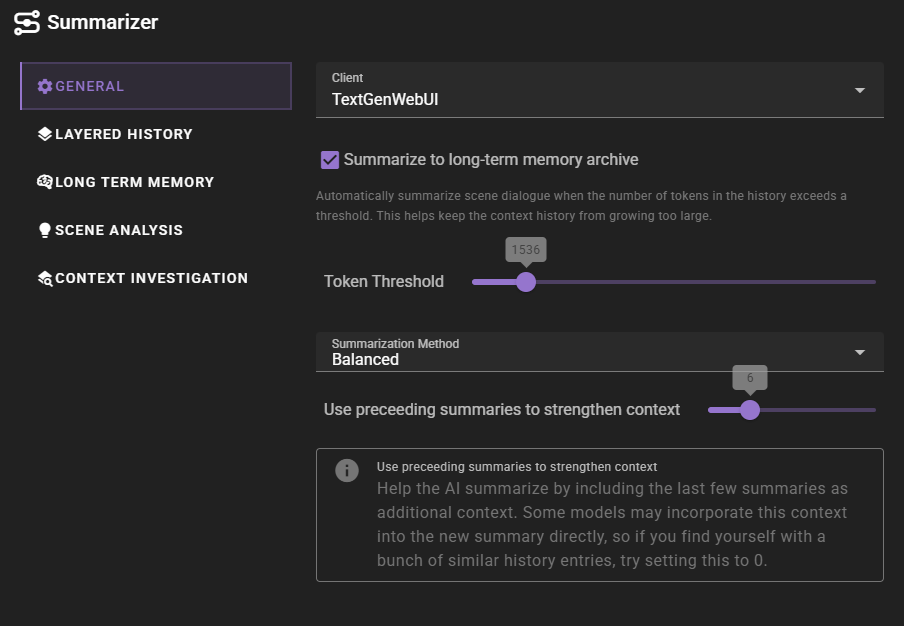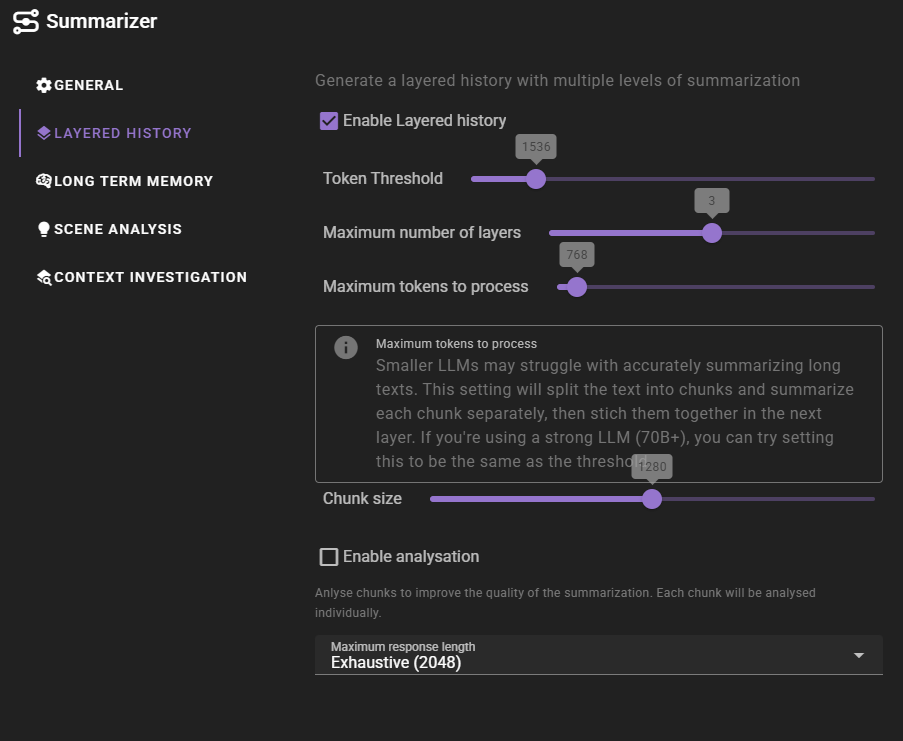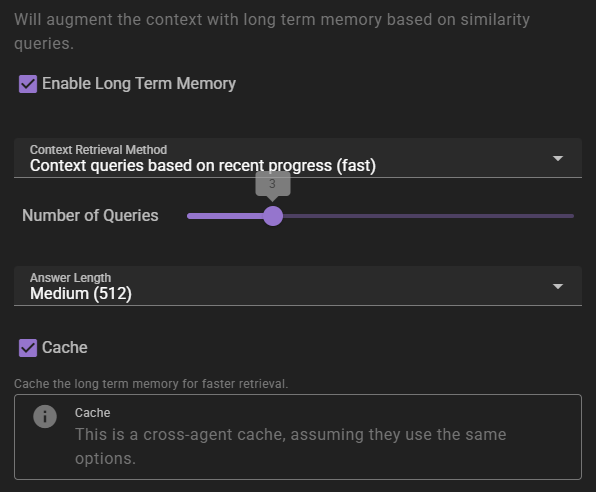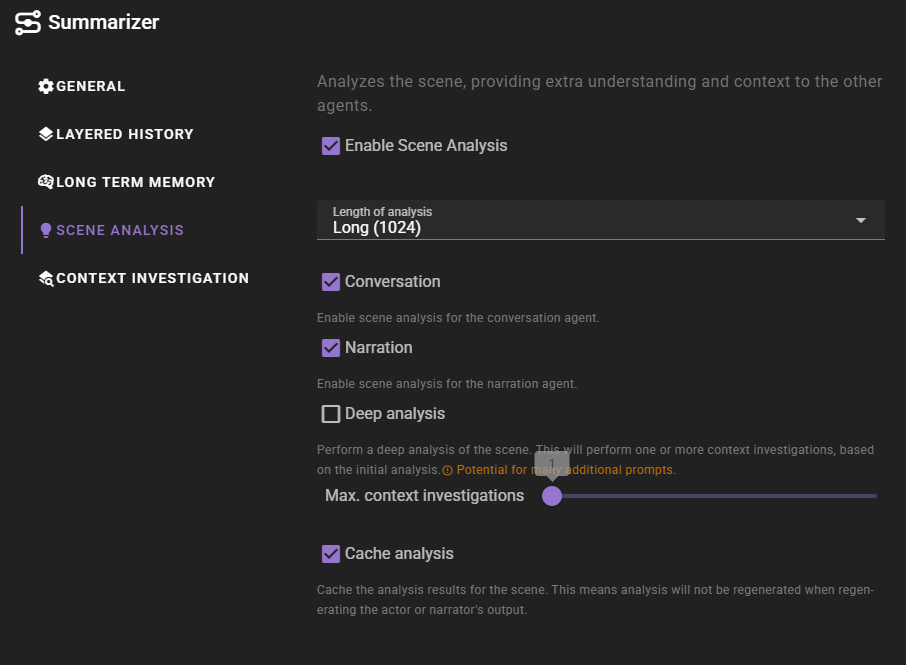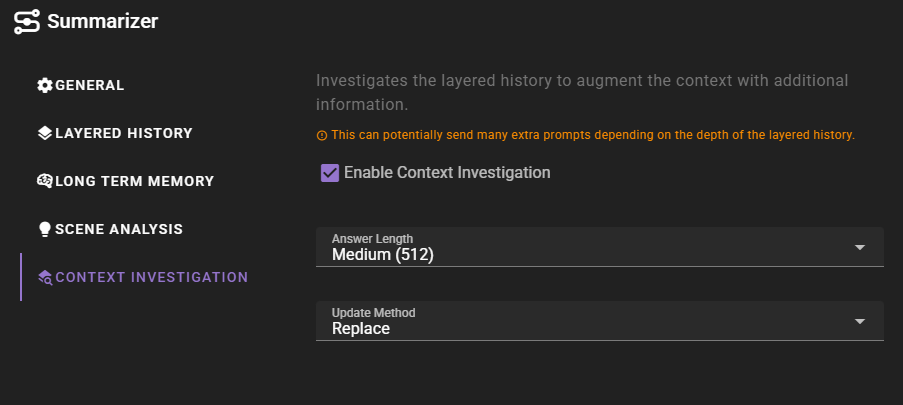Settings
General
General summarization settings.
Summarize to long term memory archive
Automatically summarize scene dialogue when the number of tokens in the history exceeds a threshold. This helps keep the context history from growing too large.
Token threshold
The number of tokens in the history that will trigger the summarization process.
Summarization method
The method used to summarize the scene dialogue.
Balanced- medium length summaryShort & Concise- short summaryLengthy & Detailed- long summaryFactual list- numbered list of events that transpired
Use preceeding summaries to strengthen context
Help the AI summarize by including the last few summaries as additional context. Some models may incorporate this context into the new summary directly, so if you find yourself with a bunch of similar history entries, try setting this to 0.
Layered History
Settings for the layered history summarization.
Talemate 0.28.0 introduces a new feature called layered history summarization. This feature allows the AI to summarize the scene dialogue in layers, with each layer providing a different level of detail.
Not only does this allow to keep more context in the history, albeit with earlier layers containing less detail, but it also allows us to do history investgations to extract relevant information from the history during conversation and narration prompts.
Right now this is considered an experimental feature, and whether or not its feasible in the long term will depend on how well it works in practice.
Enable layered history
Allows you to enable or disable the layered history summarization.
Enabling this on big scenes
If you enable this on a big established scene, the next time the summarization agent runs, it will take a while to process the entire history and generate the layers.
Token threshold
The number of tokens in the layer that will trigger the summarization process to the next layer.
Maximum number of layers
The maximum number of layers that can be created. Raising this limit past 3 is likely to have dimishing returns. We have observed that usually by layer 3 you are down to single sentences for individual events, making it difficult to summarize further in a meaningful way.
Maximum tokens to process
Smaller LLMs may struggle with accurately summarizing long texts. This setting will split the text into chunks and summarize each chunk separately, then stitch them together in the next layer. If you're using a strong LLM (70B+), you can try setting this to be the same as the threshold.
Setting this higher than the token threshold does nothing.
Chunk size
During the summarization itself, the text will be furhter split into chunks where each chunk is summarized separately. This setting controls the size of those chunks. This is a character length setting, NOT token length.
Enable analyzation
Enables the analyzation of the chunks and their relationship to each other before summarization. This can greatly improve the quality of the summarization, but will also result in a bigger size requirement of the output.
Maximum response length
The maximum length of the response that the summarizer agent will generate.
Analyzation requires a bigger length
If you enable analyzation, you should set this to be high enough so the response has room for both the analysis and the summary of all the chunks.
Long term memory
If enabled will inject relevant information into the context using relevancy through the Memory Agent.
Context Retrieval Method
What method to use for long term memory selection
Context queries based on recent context- will take the last 3 messages in the scene and select relevant context from them. This is the fastest method, but may not always be the most relevant.Context queries generated by AI- will generate a set of context queries based on the current scene and select relevant context from them. This is slower, but may be more relevant.AI compiled questions and answers- will use the AI to generate a set of questions and answers based on the current scene and select relevant context from them. This is the slowest, and not necessarily better than the other methods.
Number of queries
This settings means different things depending on the context retrieval method.
- For
Context queries based on recent contextthis is the number of messages to consider. - For
Context queries generated by AIthis is the number of queries to generate. - For
AI compiled questions and answersthis is the number of questions to generate.
Answer length
The maximum response length of the generated answers.
Cache
Enables the agent wide cache of the long term memory retrieval. That means any agents that share the same long term memory settings will share the same cache. This can be useful to reduce the number of queries to the memory agent.
Scene Analysis
When enabled scene analysis will be performed during conversation and narration tasks. This analysis will be used to provide additional context to other agents, which should hopefully improve the quality of the generated content.
Length of analysis
The maximum number of tokens for the response. (e.g., how long should the analysis be).
Conversation
Enable scene analysis for conversation tasks.
Narration
Enable scene analysis for narration tasks.
Deep analysis
Enable context investigations based on the initial analysis.
Max. content investigations
The maximum number of content investigations that can be performed. This is a safety feature to prevent the AI from going overboard with the investigations. The number here is to be taken per layer in the history. So if this is set to 1 and there are 2 layers, this will perform 2 investigations.
Cache analysis
Cache the analysis results for the scene. Enable this to prevent regenerationg the analysis when you regenerate the most recent output.
Info
This cache is anchored to the last message in the scene (excluding the current message). Editing that message will invalidate the cache.
Context investigation
When enabled, the summarizer agent will dig into the layers of the history to find context that may be relevant to the current scene.
Info
This is currently only triggered during deep analysis as part of the scene analysis. Disabling context investigation will also disable the deep analysis.
Answer length
The maximum length of the answer that the AI will generate.
Update method
How to update the context with the new information.
Replace- replace the context with the new informationSmart merge- merge the new information with the existing context (uses another LLM promp to generate the merge)
